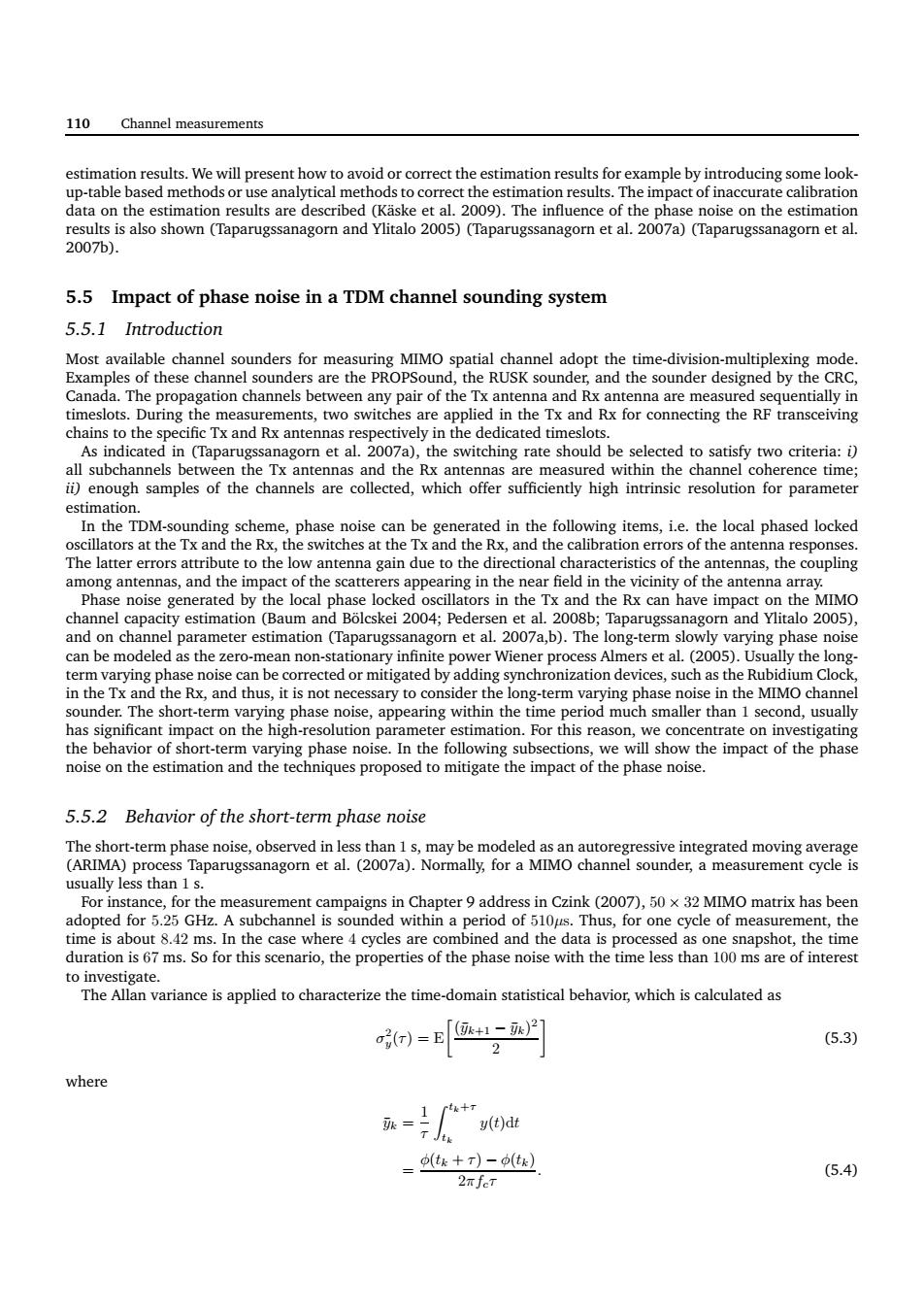正在加载图片...

110 Channel measurements rs Wo will 5.5 Impact of phase noise in a TDM channel sounding system 5.5.1 Introduction Most available channel sounders for measuring mmo spatial channel adopt the time-division-multiplexing mode Examples of these channel soun ii)enough samples of the channels are collected,which offer sufficiently high intrinsic resolution for parameter 中R贤的子发。 ed in the following items.ie.the local phased locked s of the antenna response ng in the near oupling 2004, ete 020056 can be modeled as the zero-mean non-stationary infinite power Wiener process Almers et al (2005).Usually the long erm varying phase corrected or mi ated by ding synchronization devices,such as Clo nd t der Thehor varyn phaseppwthn themwe eriod much smaller than I second,usually noise on the estimation and the techniques proposed to mitigate the impact of the phase noise. 5.5.2 Behavior of the short-term phase noise e for the measurement campaigns in Chapter9 address in Czink(2007),50x32 MIMO matrix has beer duration is 7ms.so for this scenario.the properties of the phase noise with the time less than 1 of interest (5.3) where y(t)dt -9t+)-ot (5.4) 110 Channel measurements estimation results. We will present how to avoid or correct the estimation results for example by introducing some lookup-table based methods or use analytical methods to correct the estimation results. The impact of inaccurate calibration data on the estimation results are described (Käske et al. 2009). The influence of the phase noise on the estimation results is also shown (Taparugssanagorn and Ylitalo 2005) (Taparugssanagorn et al. 2007a) (Taparugssanagorn et al. 2007b). 5.5 Impact of phase noise in a TDM channel sounding system 5.5.1 Introduction Most available channel sounders for measuring MIMO spatial channel adopt the time-division-multiplexing mode. Examples of these channel sounders are the PROPSound, the RUSK sounder, and the sounder designed by the CRC, Canada. The propagation channels between any pair of the Tx antenna and Rx antenna are measured sequentially in timeslots. During the measurements, two switches are applied in the Tx and Rx for connecting the RF transceiving chains to the specific Tx and Rx antennas respectively in the dedicated timeslots. As indicated in (Taparugssanagorn et al. 2007a), the switching rate should be selected to satisfy two criteria: i) all subchannels between the Tx antennas and the Rx antennas are measured within the channel coherence time; ii) enough samples of the channels are collected, which offer sufficiently high intrinsic resolution for parameter estimation. In the TDM-sounding scheme, phase noise can be generated in the following items, i.e. the local phased locked oscillators at the Tx and the Rx, the switches at the Tx and the Rx, and the calibration errors of the antenna responses. The latter errors attribute to the low antenna gain due to the directional characteristics of the antennas, the coupling among antennas, and the impact of the scatterers appearing in the near field in the vicinity of the antenna array. Phase noise generated by the local phase locked oscillators in the Tx and the Rx can have impact on the MIMO channel capacity estimation (Baum and Bölcskei 2004; Pedersen et al. 2008b; Taparugssanagorn and Ylitalo 2005), and on channel parameter estimation (Taparugssanagorn et al. 2007a,b). The long-term slowly varying phase noise can be modeled as the zero-mean non-stationary infinite power Wiener process Almers et al. (2005). Usually the longterm varying phase noise can be corrected or mitigated by adding synchronization devices, such as the Rubidium Clock, in the Tx and the Rx, and thus, it is not necessary to consider the long-term varying phase noise in the MIMO channel sounder. The short-term varying phase noise, appearing within the time period much smaller than 1 second, usually has significant impact on the high-resolution parameter estimation. For this reason, we concentrate on investigating the behavior of short-term varying phase noise. In the following subsections, we will show the impact of the phase noise on the estimation and the techniques proposed to mitigate the impact of the phase noise. 5.5.2 Behavior of the short-term phase noise The short-term phase noise, observed in less than 1 s, may be modeled as an autoregressive integrated moving average (ARIMA) process Taparugssanagorn et al. (2007a). Normally, for a MIMO channel sounder, a measurement cycle is usually less than 1 s. For instance, for the measurement campaigns in Chapter 9 address in Czink (2007), 50 × 32 MIMO matrix has been adopted for 5.25 GHz. A subchannel is sounded within a period of 510µs. Thus, for one cycle of measurement, the time is about 8.42 ms. In the case where 4 cycles are combined and the data is processed as one snapshot, the time duration is 67 ms. So for this scenario, the properties of the phase noise with the time less than 100 ms are of interest to investigate. The Allan variance is applied to characterize the time-domain statistical behavior, which is calculated as σ 2 y (τ) = E (¯yk+1 − y¯k) 2 2 (5.3) where y¯k = 1 τ Z tk+τ tk y(t)dt = φ(tk + τ) − φ(tk) 2πfcτ . (5.4)